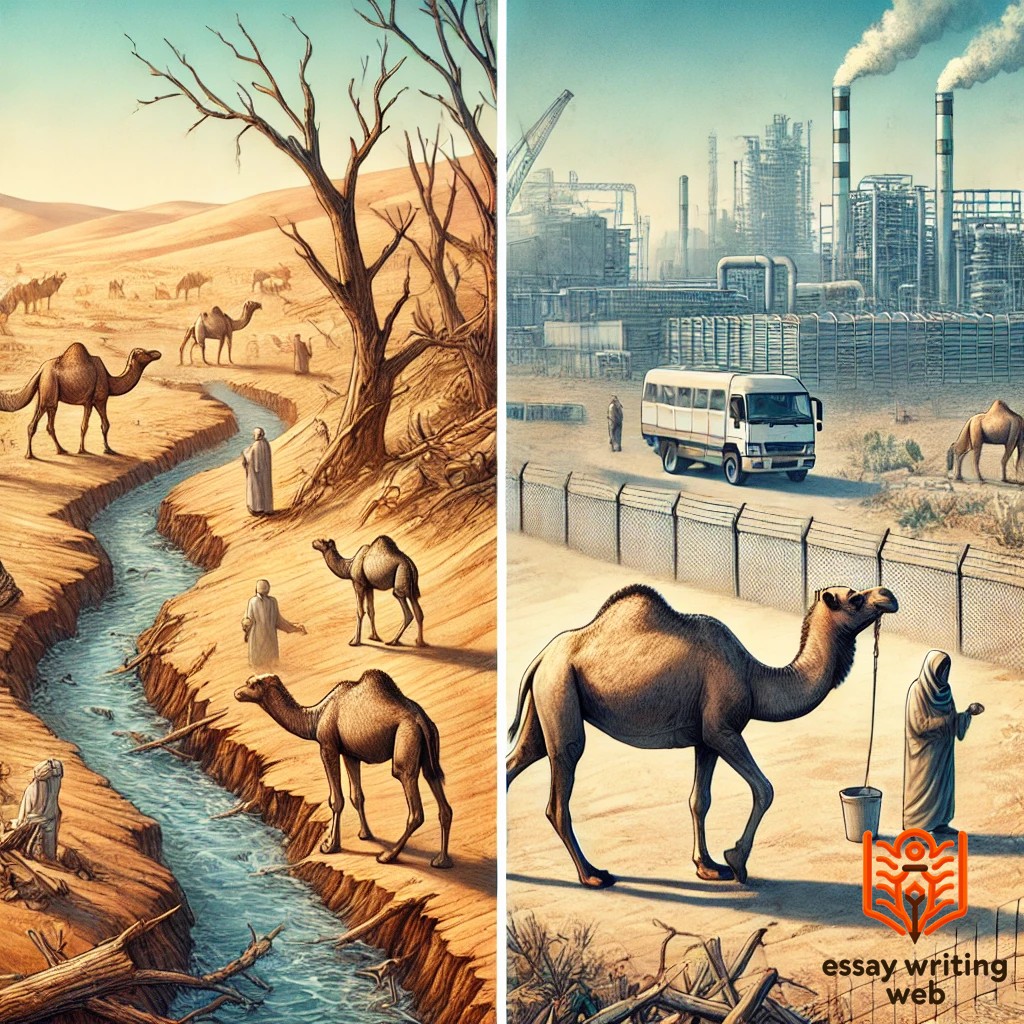 Essay Writing Web
Essay Writing Web

 16-09-2024
16-09-2024
 www.essaywritingweb.com
www.essaywritingweb.com
The camel, often referred to as the "ship of the desert," is one of nature's most fascinating and resilient creatures. Known for its ability to thrive in some of the harshest environments on Earth, camels have played a vital role in human history and continue to be of great importance in many desert cultures today. Found primarily in the arid regions of the Middle East, North Africa, and parts of Asia, the camel is perfectly adapted to life in hot, dry climates.
Both types are uniquely designed to store fat in their humps, which allows them to survive for long periods without food and water. In addition to their humps, camels have several other physical adaptations that enable them to endure extreme heat and limited resources. Their thick fur protects them from the sun during the day and provides warmth during the cold desert nights. Long legs keep their bodies away from the hot ground, while their large, padded feet allow them to walk easily on sand.
Historically, camels have been indispensable to the survival of desert civilizations. They have served as a primary mode of transportation, carrying goods and people across vast desert expanses in ancient trade routes like the Silk Road. Moreover, camels provide essential resources such as milk, meat, and wool for the communities that rely on them. In modern times, camels remain central to life in many parts of the world, particularly in rural desert areas.
The camel's unique adaptations and enduring importance to human life make it a symbol of resilience and survival, perfectly suited to the challenging desert environment it calls home.
There are two primary types of camels: the dromedary camel and the Bactrian camel. These two species are distinguished by the number of humps on their backs, which also reflects their adaptation to different environmental conditions. Despite these differences, both types share certain traits that make them well-suited for survival in arid and challenging landscapes.
The dromedary camel, also known as the Arabian camel, is the most common camel species, comprising about 90% of the world’s camel population. This camel has a single hump on its back and is native to the deserts of North Africa, the Middle East, and parts of South Asia. The dromedary camel is perfectly adapted to the hot and dry climates of these regions. Its large hump stores fat, which can be converted into energy when food and water are scarce. This allows dromedaries to survive long periods of time without eating or drinking.
Dromedary camels have long legs, which help to keep their bodies away from the hot desert ground, and their wide, padded feet prevent them from sinking into the sand. They are commonly used as a means of transportation in desert areas, as well as for their milk, meat, and wool.

The Bactrian camel is the less common of the two species and is primarily found in the cold deserts and steppes of Central Asia, including parts of Mongolia, China, and Kazakhstan. Unlike the dromedary camel, the Bactrian camel has two humps, which store fat similarly to its one-humped relative. However, Bactrian camels are adapted to much colder climates and are covered with thick, shaggy fur that helps them endure harsh winters.
Bactrian camels are known for their strength and endurance, making them ideal for carrying heavy loads over long distances in rugged terrains. Their dual humps provide them with better energy storage, and they can survive on minimal food and water.
In summary, both the dromedary and Bactrian camels are remarkable creatures that have evolved to thrive in drastically different environments. Their unique adaptations highlight the camel’s incredible resilience and versatility in some of the world’s most challenging climates.

Camels possess unique physical characteristics that make them highly adaptable to harsh environments, particularly desert regions. One of the most iconic features of a camel is its hump, or in the case of the Bactrian camel, its two humps. These humps store fat, which camels can metabolize into energy and water when food and water are scarce. Contrary to popular belief, the humps do not store water but allow the camel to endure long periods without it.
Camels have long, strong legs that elevate their bodies away from the hot desert ground, providing them with protection from the intense heat. Their broad, padded feet are specially adapted to prevent sinking into the sand, allowing them to move easily across desert landscapes. In addition to their legs and feet, camels have large, bushy eyebrows and long eyelashes that protect their eyes from sand and sunlight. Their nostrils can close tightly, shielding their respiratory system from blowing sand during sandstorms.
The fur of a camel is another crucial adaptation. It is thick and insulating, helping camels cope with both the extreme heat of the day and the cold nights in the desert. Dromedary camels have shorter fur, suited for hot climates, while Bactrian camels have longer, shaggy fur, which helps them withstand colder temperatures.
Overall, the camel’s physical traits have evolved to ensure its survival in some of the world’s most unforgiving terrains, making it an exceptional example of nature’s adaptability.

Camels are remarkable animals, uniquely adapted to survive in some of the harshest environments on Earth. Their diet primarily consists of tough, dry vegetation commonly found in arid and desert regions, such as thorny plants, dry grasses, and shrubs. What makes camels truly unique is their ability to consume vegetation that most other animals avoid, like salty plants and thorny bushes. Their thick lips and tough mouth linings allow them to chew on these harsh plants without injury.
Camels possess a highly efficient digestive system, which allows them to extract the maximum amount of nutrients and water from their food. This ability helps them survive in regions where food and water are scarce. While camels can go for long periods without drinking water, they compensate by extracting moisture from their food and efficiently storing fat in their humps, which they metabolize when food is unavailable.
Their feeding habits vary slightly between the two main camel species, the Dromedary and the Bactrian. Dromedary camels, found in the hot deserts of the Middle East and Africa, tend to graze on thorny shrubs and dry grasses, while Bactrian camels, found in the colder deserts of Central Asia, may consume more diverse vegetation, including grasses and leaves.
Overall, camels have evolved extraordinary feeding habits that enable them to thrive in environments where other animals would struggle, making them essential to the livelihoods of many desert-dwelling communities.
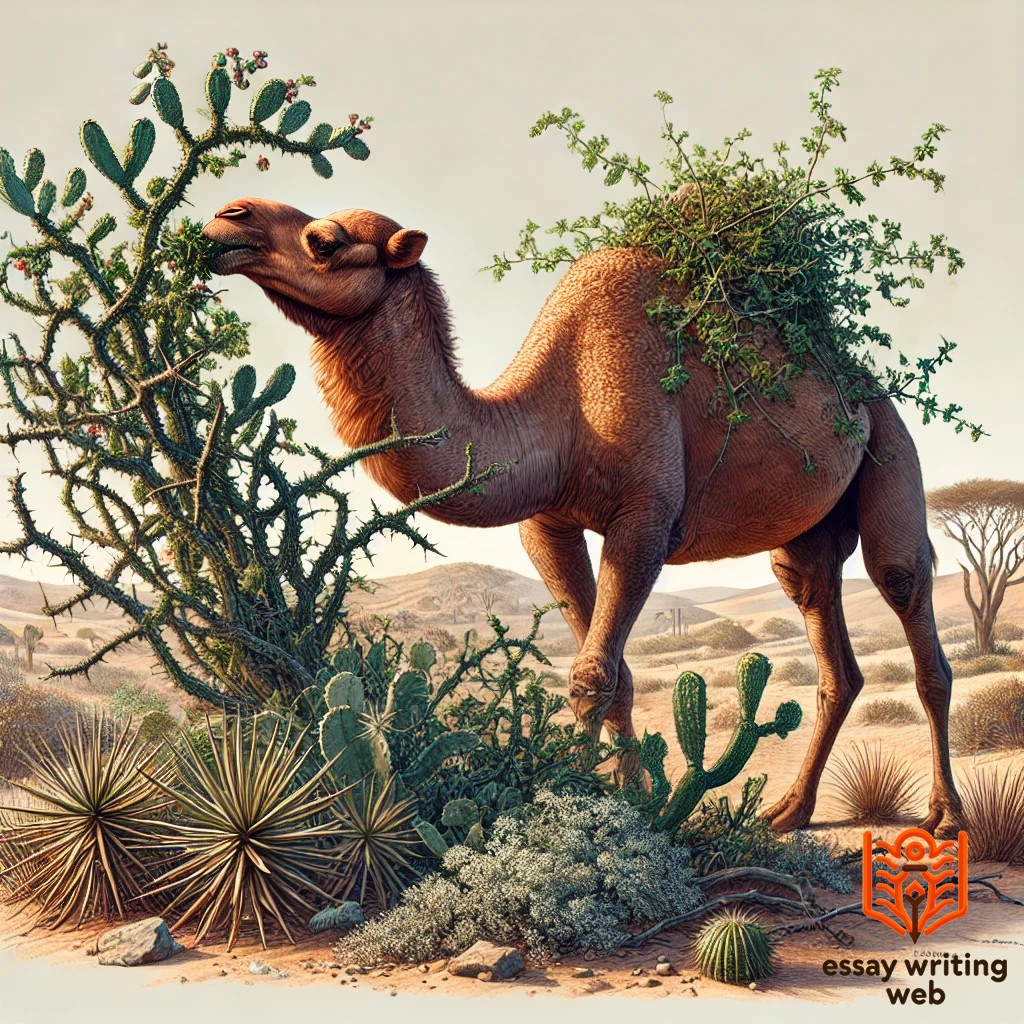
Camels are extraordinary animals known for their remarkable ability to survive in environments with scarce food and water. Their unique adaptations allow them to thrive in the harsh conditions of deserts. One of the key features is the camel’s ability to store fat in their humps, not water, as commonly believed. This fat serves as an energy reserve, which can be metabolized into water and energy when food sources are limited. This allows camels to go for several weeks without eating solid food.
In addition to fat storage, camels are highly efficient in their water usage. They can drink up to 40 gallons of water in a single session when it is available, replenishing their reserves quickly. They also have the ability to tolerate significant dehydration, losing up to 25% of their body weight in water without suffering ill effects, a capacity that would be fatal for most other animals. Their bodies conserve water through various physiological mechanisms, such as producing concentrated urine and dry feces.
Camels have a flexible diet and can eat thorny, dry plants that most animals cannot consume, thanks to their tough, split upper lip and specialized mouth. This dietary flexibility allows them to feed on the sparse vegetation available in desert regions.
Moreover, their thick coats protect them from the extreme temperatures of the desert, reducing water loss through sweating. These remarkable adaptations make camels well-suited to survive in environments where food and water are limited.

Camels have played a vital role in human society for thousands of years, especially in desert and arid regions where few other animals can thrive. Known as the "ships of the desert," camels have been indispensable for transportation, trade, and survival in these harsh environments. Their ability to carry heavy loads over long distances without needing much water made them essential for ancient trade routes like the Silk Road and trans-Saharan caravans. Camels allowed for the exchange of goods, culture, and ideas between distant civilizations.
Beyond transportation, camels have provided humans with vital resources. They are a source of milk, which is rich in nutrients and can be consumed fresh or made into products like butter and cheese. In many cultures, camel milk is considered a staple food, particularly in regions where cattle cannot survive. Camels are also valued for their meat, which provides nourishment in resource-scarce areas.
In addition, camels are used for their wool, hides, and dung, which serve as fuel and material for clothing and shelter. Their presence is integral to the livelihoods of many nomadic and pastoral communities, as they provide both economic and cultural significance.
In modern times, camels continue to be valuable, especially in tourism, where they are used for rides and desert safaris. Overall, camels have had a profound impact on human society, particularly in sustaining life and commerce in some of the world’s most inhospitable regions.
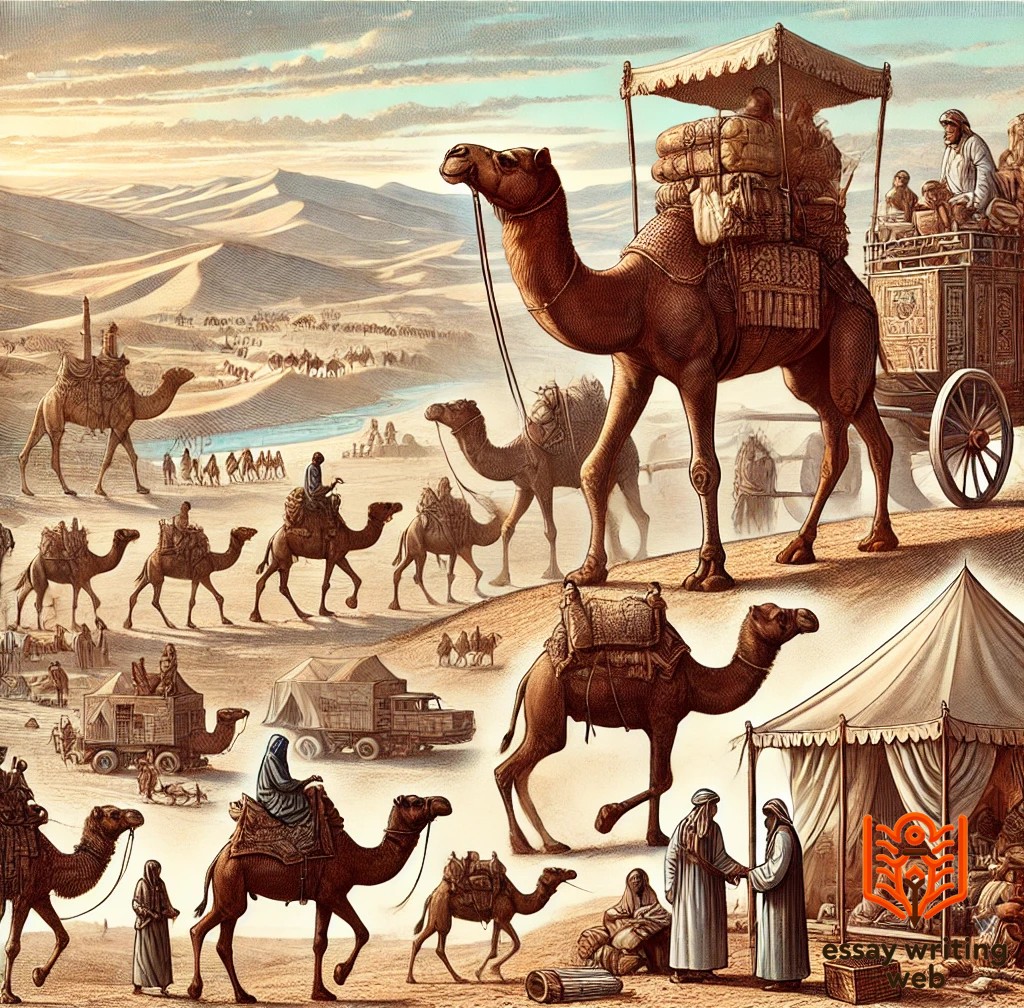
Camels have long been known as the "ships of the desert" due to their crucial role in transportation across arid and desert regions. Their unique physical adaptations make them ideal for navigating the harsh terrain of deserts where extreme heat, lack of water, and vast expanses of sand would make other forms of transportation nearly impossible.
Camels are capable of carrying heavy loads, often up to 600 pounds, for long distances without needing much water or food. Their padded feet allow them to walk comfortably on the soft, shifting sand, while their ability to withstand extreme temperatures makes them perfect for desert travel. These traits have made camels indispensable for trade and communication across regions like the Middle East, North Africa, and Central Asia.
Historically, camels have been essential for trade caravans, particularly on the Silk Road and in trans-Saharan commerce, facilitating the exchange of goods and cultures between distant lands. They have also been used to transport people, offering a reliable means of travel in areas where motorized vehicles cannot function.
Today, while modern transportation has reduced the reliance on camels, they remain an important symbol of resilience in desert cultures, and are still used in tourism, especially for desert treks and safaris.
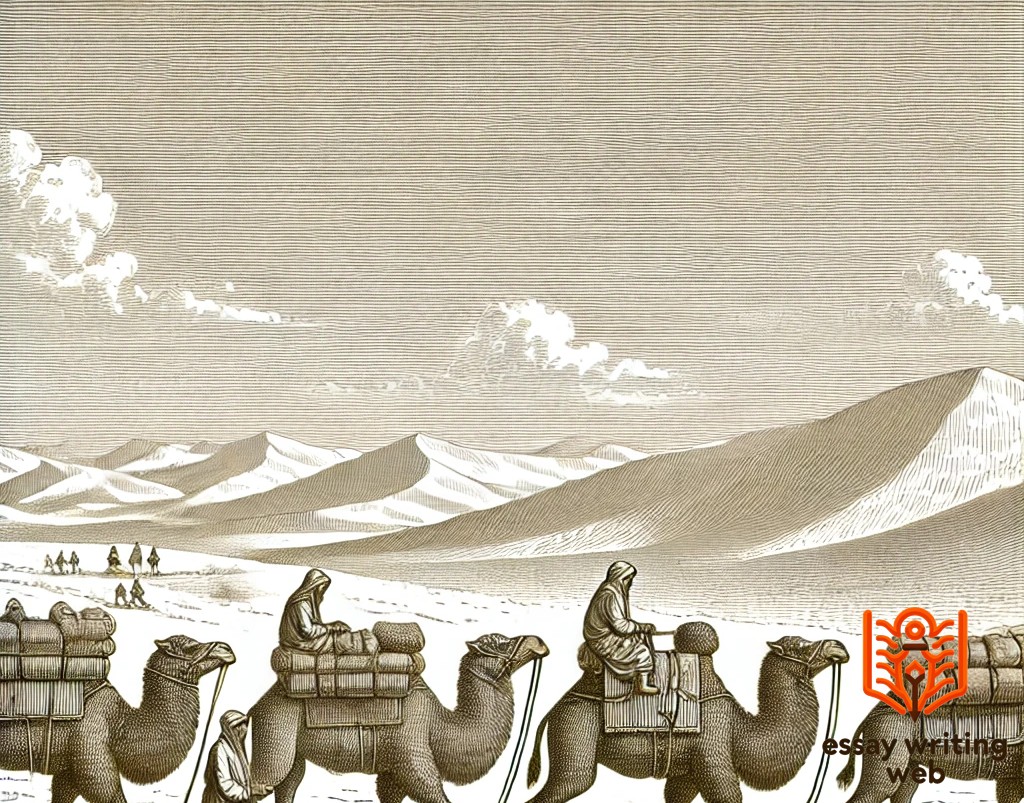
Camels hold significant economic importance, particularly in regions where harsh climates limit the use of other livestock and transportation methods. In arid and semi-arid areas of the Middle East, Africa, and parts of Asia, camels are an essential resource for transportation, food, clothing, and trade. Their ability to thrive in extreme conditions makes them invaluable for the livelihoods of many communities.
One of the primary economic contributions of camels is their role in transportation. Known as the "ships of the desert," camels have historically facilitated trade across vast desert regions, enabling the exchange of goods between distant markets. This trade was critical in ancient times and continues to be relevant in remote areas where motor vehicles are impractical.
Camels are also vital for their milk, which is rich in nutrients and can be a significant food source in desert regions. Camel milk is not only consumed locally but is also increasingly traded in global markets due to its health benefits. Camel meat, though less common, provides sustenance in areas where other protein sources are scarce.
Additionally, camels provide wool, hides, and leather, all of which are used for clothing and various products. Their wool is particularly valued for its durability and warmth in colder desert climates.
In tourism, camels contribute to the economy by attracting visitors to desert safaris and cultural experiences. Overall, camels are an irreplaceable asset to the economy in regions where their adaptability and resilience make them a cornerstone of survival and commerce.
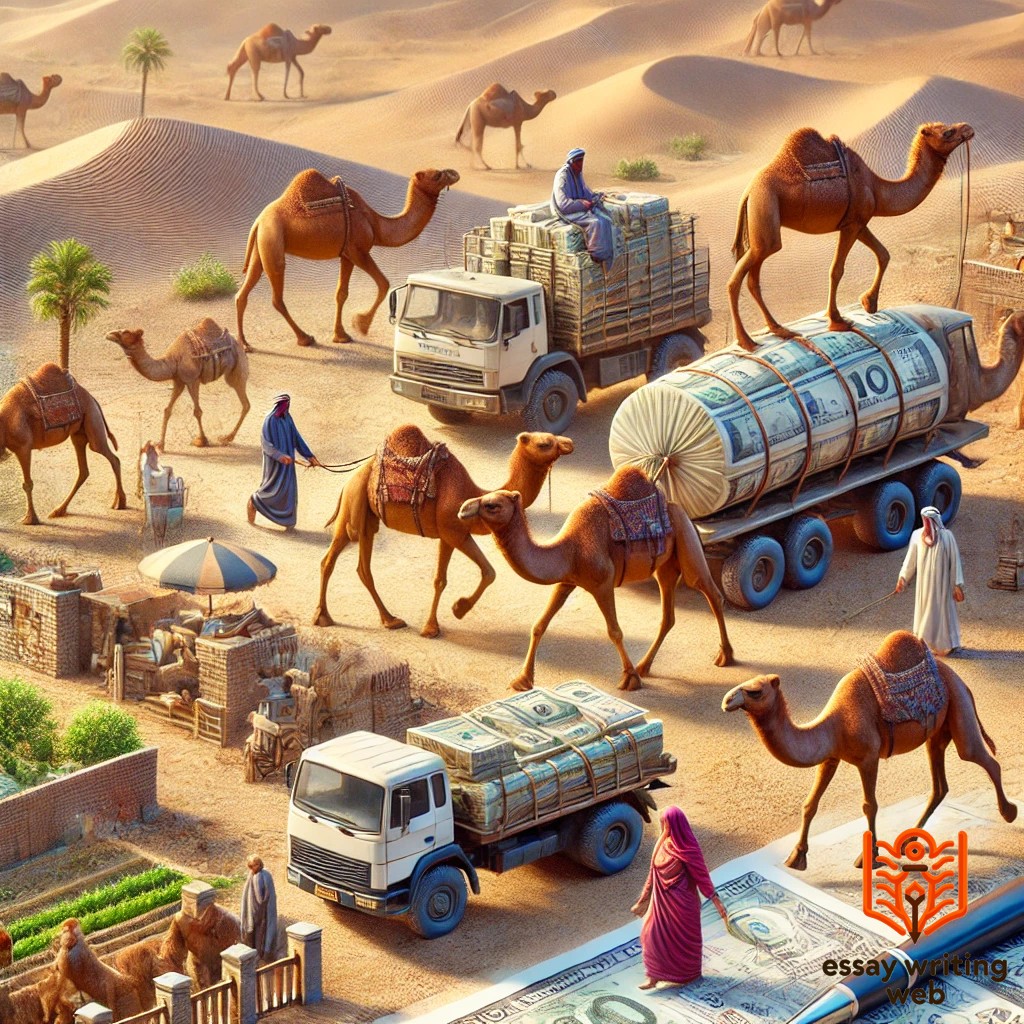
Camels have played a significant role in both history and religion, particularly in regions where they have been essential for survival and transportation. Throughout history, camels have been used to facilitate trade and communication between distant civilizations. In the ancient world, camels were crucial for caravans traveling along the Silk Road, enabling the exchange of goods, culture, and ideas between Asia, Africa, and Europe. Their resilience in harsh desert environments made them indispensable for long journeys across barren landscapes, carrying goods such as spices, textiles, and precious metals.
In religion, camels hold symbolic importance in various traditions. In the Bible, camels are mentioned numerous times, often associated with wealth, trade, and survival in the desert. They played a role in stories such as those of Abraham and the Magi, who traveled by camel to visit the newborn Jesus. Similarly, in Islamic tradition, camels are highly regarded. The Prophet Muhammad is said to have traveled by camel during significant moments in his life, including his migration from Mecca to Medina. Camels are also mentioned in the Quran, symbolizing God’s creation and the importance of humility and resilience.
In pre-Islamic Arabian culture, camels were revered as essential for both survival and warfare. They were used in battles, and their milk, meat, and wool sustained desert-dwelling communities. Over centuries, camels have thus remained a symbol of strength, endurance, and spiritual significance in many cultures and religions, shaping both the history and beliefs of the people who relied on them.
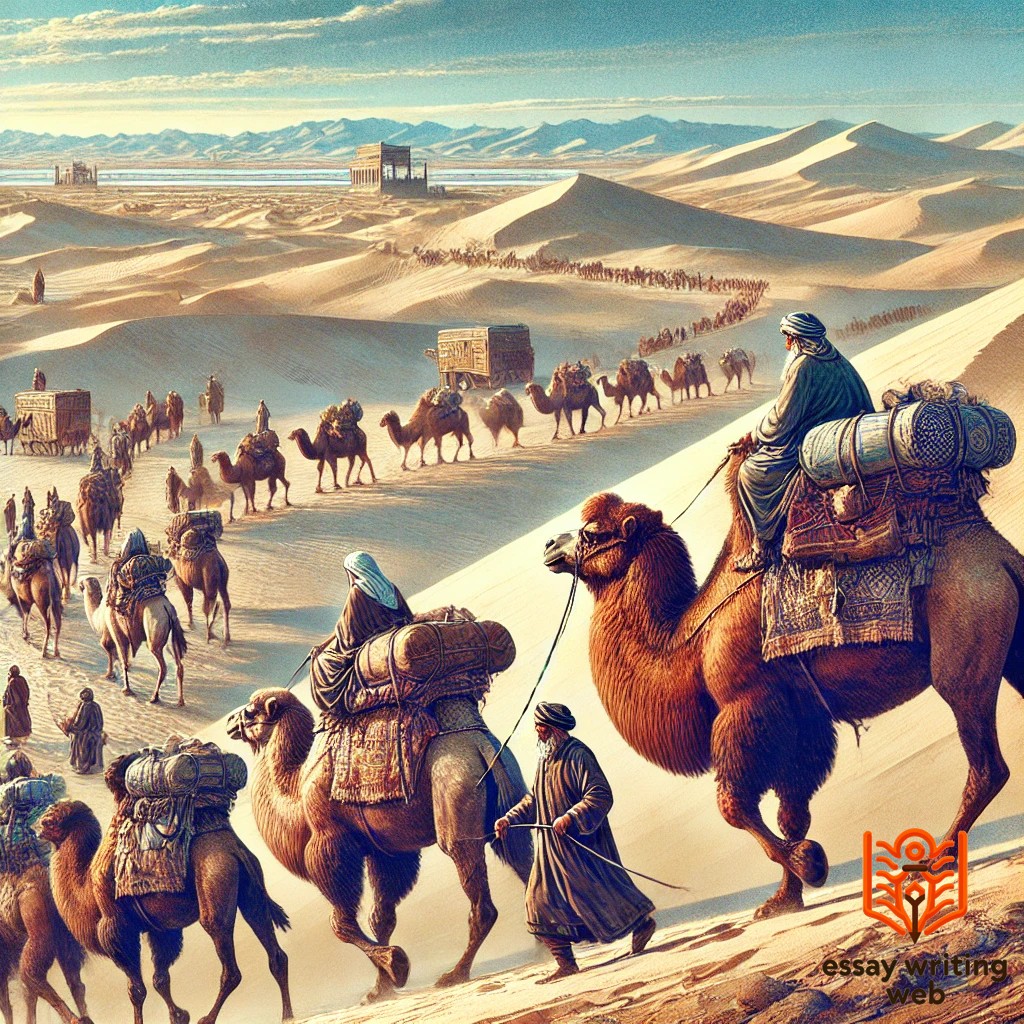
Camels, though well-adapted to harsh desert environments, face several challenges that threaten their survival. One of the primary challenges is habitat loss due to urbanization and agricultural expansion. As human settlements encroach on desert areas, camels lose access to the vast open spaces and natural resources they rely on. Overgrazing by livestock also contributes to the depletion of vegetation, further reducing the food available for camels.
Another significant challenge is climate change, which is altering desert ecosystems. Increased temperatures and changing rainfall patterns affect the availability of water and food, making survival even more difficult for camels. In some regions, prolonged droughts force camels to migrate to areas with limited resources, leading to competition with other animals.
Conservation efforts are becoming increasingly important to protect camels and their habitats. Organizations are working to promote sustainable grazing practices and protect desert ecosystems from overdevelopment. In addition, some countries have introduced breeding programs to preserve rare camel species, such as the wild Bactrian camel, which is critically endangered.
Educating local communities about the ecological and economic importance of camels can also aid in their conservation. By raising awareness, conservation efforts can ensure that camels continue to play their vital role in desert ecosystems and human society.
